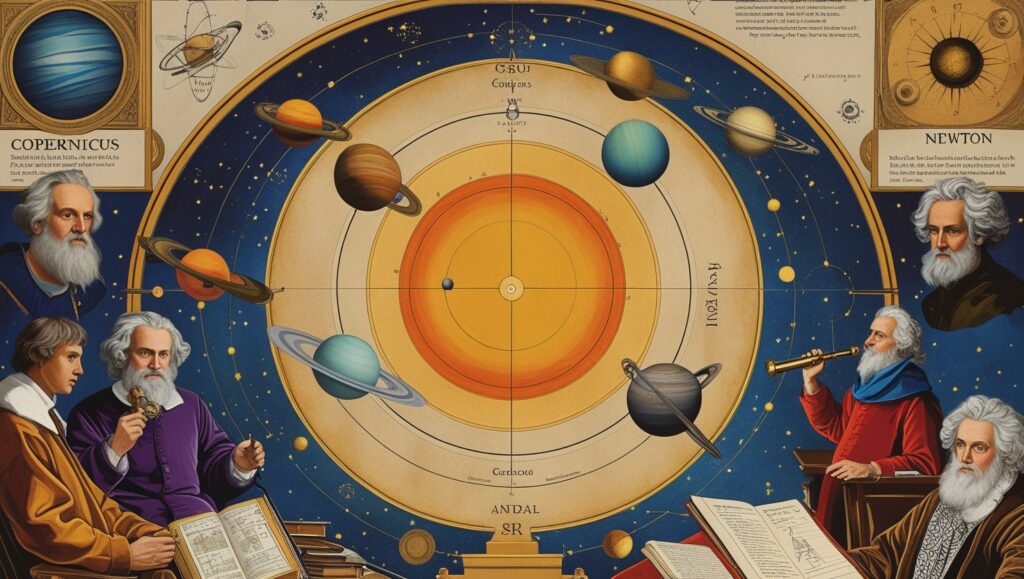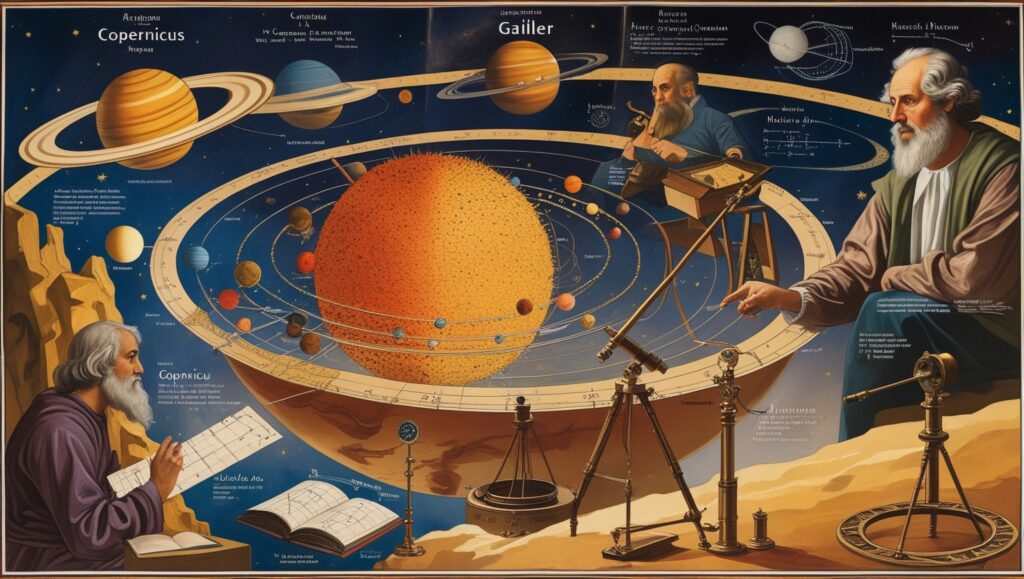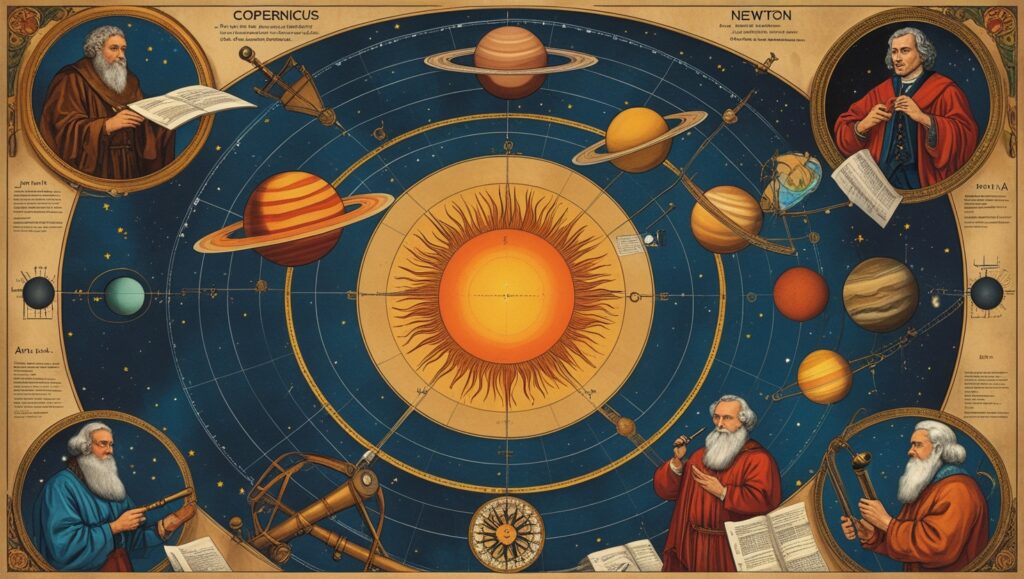The solar system has fascinated humanity for centuries, inspiring countless discoveries and theories about the cosmos. From the earliest times, humans have gazed at the night sky, marveling at the celestial bodies and their movements. Ancient civilizations built observatories, crafted myths, and created calendars based on their understanding of the heavens. Over time, these observations evolved into scientific inquiries, leading to groundbreaking revelations about the structure and dynamics of the solar system.
But who can truly claim to have “discovered” the solar system? The answer is both simple and complex. While no single individual can take full credit, the collective efforts of brilliant minds across history have gradually unveiled the mysteries of our cosmic neighborhood. These advancements were driven by ancient observations, revolutionary theories that challenged existing beliefs, and groundbreaking scientific advancements that redefined humanity’s place in the universe.
Let’s delve into the fascinating history of astronomy and explore the visionaries who shaped our understanding of the solar system. Their contributions not only expanded our knowledge but also ignited humanity’s enduring curiosity about the cosmos.
Early Observations: The Roots of Astronomical Study
Before the solar system as we know it was fully understood, ancient civilizations laid the groundwork with their observations of the skies. Early astronomers in Mesopotamia, Egypt, and Greece meticulously tracked celestial movements, recording patterns that helped shape early calendars and navigation systems. These early efforts formed the backbone of humanity’s astronomical knowledge and set the stage for future discoveries.
Babylonian Astronomers: Pioneers of Systematic Astronomy
Around 1000 BCE, Babylonian scholars began charting the movements of planets and stars with remarkable precision. They developed some of the earliest known star catalogues and were adept at predicting celestial events such as eclipses. Using tools like shadow clocks and primitive observatories, Babylonian astronomers identified patterns in the movements of the Sun, Moon, and planets. Their records not only guided agricultural practices but also influenced later Greek and Islamic astronomers, bridging the gap between ancient and classical astronomy.
Aristotle (384–322 BCE): The Geocentric Model
The Greek philosopher Aristotle played a pivotal role in shaping early astronomical thought. Building on the works of his predecessors, he proposed a geocentric model, where Earth was placed at the center of the universe. According to Aristotle, celestial bodies moved in perfect circular orbits around Earth, which was believed to be motionless. Although this model was later proven incorrect, it dominated scientific thought for nearly 1,500 years due to its alignment with observed phenomena and its adoption by influential institutions like the Catholic Church.
Aristotle’s geocentric theory was significant not only for its widespread acceptance but also for its lasting influence on scientific inquiry. His ideas provided a framework for medieval scholars and set the stage for later debates that would eventually lead to the heliocentric model of the solar system.

Copernicus: The Heliocentric Revolution
The modern concept of the solar system began to take shape in the 16th century, thanks to Nicolaus Copernicus (1473–1543). Widely regarded as the father of modern astronomy, Copernicus introduced the groundbreaking heliocentric model, which proposed that the Sun, not Earth, was at the center of the solar system. This revolutionary idea marked a turning point in the history of astronomy and set the stage for future scientific advancements.
Why Was Copernicus’ Discovery Groundbreaking?
Challenged Long-Standing Beliefs
For centuries, the geocentric model—placing Earth at the center of the universe—dominated scientific and religious thought. This view was deeply entrenched, supported by the influential works of Ptolemy and Aristotle, and upheld by the Catholic Church. Copernicus’ heliocentric model directly contradicted these long-standing beliefs, sparking a major shift in how humanity understood its place in the cosmos.
Mathematical Precision
Copernicus didn’t rely solely on philosophical reasoning to support his theory. He meticulously calculated the positions and movements of celestial bodies, using detailed mathematical models to demonstrate the feasibility of the heliocentric system. His work paved the way for a more empirical and scientific approach to astronomy, inspiring future astronomers like Galileo and Kepler to build upon his foundation.
The Publication of De Revolutionibus Orbium Coelestium
Copernicus’ ideas were formally introduced to the world in 1543 with the publication of De Revolutionibus Orbium Coelestium (“On the Revolutions of the Heavenly Spheres”). This seminal work outlined his heliocentric theory in detail, challenging readers to reconsider their understanding of the universe. While initial reactions were mixed—with some dismissing his ideas as heretical or overly complex—the book ultimately became a cornerstone of modern astronomy.
Copernicus’ Legacy
Despite facing resistance during his lifetime, Copernicus’ heliocentric model laid the groundwork for the scientific revolution. His courage to challenge established doctrines and his commitment to empirical evidence redefined astronomy and inspired generations of scientists. Today, his contributions are celebrated as a pivotal moment in our quest to understand the universe. Revolutions of the Heavenly Spheres”) in 1543 marked a turning point in our understanding of the cosmos.
Galileo Galilei: The Telescope Pioneer
Galileo Galilei (1564–1642) played a crucial role in validating Copernicus’ heliocentric theory and advancing our understanding of the solar system. Widely recognized as the father of observational astronomy, Galileo refined the telescope to make groundbreaking discoveries that provided compelling evidence for the Sun-centered model.
Key Discoveries by Galileo
Moons of Jupiter
In 1610, Galileo discovered four moons orbiting Jupiter—Io, Europa, Ganymede, and Callisto—using his newly improved telescope. These celestial bodies, now known as the Galilean moons, demonstrated for the first time that not all objects in the cosmos revolved around Earth. This observation dealt a significant blow to the geocentric model and underscored the validity of Copernicus’ heliocentric theory.
Phases of Venus
Galileo’s detailed observations of Venus revealed that the planet exhibited phases similar to those of the Moon. These phases could only be explained if Venus orbited the Sun, further affirming the heliocentric model. This discovery was a direct challenge to the Ptolemaic system, which could not account for such phenomena.
Surface of the Moon
Through his meticulous sketches, Galileo showed that the Moon’s surface was far from smooth and perfect. He identified mountains, valleys, and craters, challenging the long-held Aristotelian belief in the celestial realm’s perfection. This revelation not only redefined humanity’s view of the Moon but also encouraged a more critical approach to studying celestial bodies.
Opposition and Persecution
Despite his monumental contributions, Galileo faced fierce opposition from the Catholic Church, which upheld the geocentric model as a theological truth. In 1633, he was tried by the Inquisition and forced to recant his support for the heliocentric theory. Galileo spent the remainder of his life under house arrest, but his work continued to influence future generations of scientists.
Galileo’s Legacy
Galileo’s innovative use of the telescope and his commitment to empirical observation cemented his place as a pioneer of modern science. His discoveries not only validated Copernicus’ heliocentric model but also laid the foundation for future astronomical research. Today, Galileo is celebrated as a trailblazer who dared to challenge established doctrines and expand humanity’s understanding of the cosmos.

Johannes Kepler: Unraveling Planetary Motion
Building on the work of Copernicus and Galileo, Johannes Kepler (1571–1630) introduced precise mathematical laws governing planetary motion. These laws revolutionized astronomy by providing a detailed understanding of how planets move within the solar system.
Kepler’s Three Laws of Planetary Motion
1. Elliptical Orbits
Kepler discovered that planets move in elliptical, not circular, orbits around the Sun. This departure from the perfect circles of earlier models provided a more accurate description of planetary motion.
2. Equal Areas in Equal Times
Kepler’s second law states that a line connecting a planet to the Sun sweeps out equal areas in equal intervals of time. This means that planets move faster when closer to the Sun and slower when farther away, explaining variations in their speeds.
3. Harmonic Law
The square of a planet’s orbital period is proportional to the cube of its average distance from the Sun. This relationship provided a mathematical framework for understanding the dynamics of planetary orbits.
Bridging Observation and Theory
Kepler’s insights bridged the gap between empirical observations and theoretical models. By combining precise data from Tycho Brahe’s astronomical observations with his own mathematical expertise, Kepler transformed the study of planetary motion into a predictive science.
Influence on Isaac Newton
Kepler’s laws laid the groundwork for Isaac Newton’s theory of universal gravitation. By describing how planets moved, Kepler set the stage for Newton to explain why they moved, completing the picture of celestial mechanics.
Kepler’s Legacy
Johannes Kepler’s contributions revolutionized our understanding of the solar system. His laws remain fundamental to modern astronomy, guiding everything from space exploration to the study of exoplanets. Kepler’s work exemplifies the power of combining observation, mathematics, and theory to unlock the secrets of the universe.

Sir Isaac Newton: The Force Behind It All
Isaac Newton (1643–1727) provided the final piece of the puzzle with his law of universal gravitation. Newton’s groundbreaking work explained why planets orbit the Sun and how gravity governs celestial bodies.
Newton’s Contributions
Mathematical Principles of Natural Philosophy
Published in 1687, this seminal work, often referred to as the Principia, unified Kepler’s laws of planetary motion with the physics of motion. Newton’s equations described the forces acting upon celestial objects, laying the groundwork for classical mechanics.
Universal Gravitation
Newton demonstrated that the same force keeping objects on Earth grounded—gravity—also governs planetary motion. His law of universal gravitation established that every mass attracts every other mass in the universe, with a force proportional to their masses and inversely proportional to the square of the distance between them. This insight provided a unifying explanation for both terrestrial and celestial phenomena.
Newton’s Legacy
Newton’s contributions marked a turning point in the history of science. By combining observational data with mathematical principles, he established a framework that would dominate scientific thought for centuries. His work not only explained the mechanics of the solar system but also inspired future explorations into the nature of the universe. Today, Newton is celebrated as one of the greatest scientists of all time, whose discoveries continue to shape our understanding of the cosmos.
The discovery of the solar system was not the achievement of a single individual but a collective journey of human curiosity and ingenuity. From ancient stargazers to modern scientists, each contributed a piece to the puzzle.
As you explore more about astronomy and the cosmos, consider how these discoveries continue to shape our understanding of the universe. Whether you’re gazing at the stars or reading about space exploration, the legacy of these pioneers invites you to keep asking questions.
Ready to Discover More?
Dive deeper into the wonders of the universe and uncover how modern technology is expanding our understanding of space.









